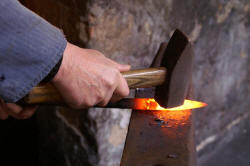Understanding the passive voice in English

This short lesson will help you do three things:
- Make the form of a passive clause accurately.
- Know when to use passive clauses.
- Understand passive clauses and why they are used.
We will start with the grammar and form.
 |
Forming the passive |
In English there are two voices: active and passive.
They look like this:
- Active voice
- John stole the book
In this sentence, we know who did what and we know what happened to the book. - Passive voice
- The book was stolen
In this sentence, we know what happened to the book but we do not know who did it.
Let's take the first sentence, John stole the book, and see what the grammar is. We have:
| The subject | The verb | The object |
| John | stole | the book |
 |
Task 1:
It is important to understand this so try a little test to
see if you can say what the subjects, the verbs and the
objects are in these sentences. Click on |
- Mary opened the letter
- My sister and I have bought tickets to the concert
- The old man in the corner with the dog has been telling really good stories
- She went to London
| The subject | The verb | The object | |
| 1 | Mary | opened | the letter |
| 2 | My sister and I | have bought | tickets to the concert |
| 3 | The old man in the corner with the dog | has been telling | really good stories |
| 4 | She | went | NO OBJECT! |
You can see that subjects, verbs and objects can be more than one
word. In these examples, we have subject, verb and object
phrases not just single words.
The other important thing to notice is that some verbs cannot have
an object at all. They are called intransitive verbs and other
examples are appear,
arrive,
come,
fall,
go,
happen,
lie,
listen, live,
rise,
snow, wait and walk. There are lots more.
With these verbs it is not possible to make a passive
sentence.
When we have a passive sentence, the grammar is different and we do it like this:
| The patient | The verb | plus sometimes | The agent |
| The letter | was opened | by Mary | |
| Tickets to the concert | have been bought | by my sister and I |
Most of the time, we do not say what the agent is because we are more interested in the patient.
 |
Task
2:
Look at the verb in the passive sentences. What do you notice? Click on |
We have changed
opened
to
was opened
and we have changed
have bought
to
have been bought
by putting in the verb be in the correct tense form.
 |
Task
3:
Look at these two sentences. The first is active and
the second is passive. What do you notice about the verb? Click on |
- John wrote a letter
- A letter was written
We have put in the verb be as we did before, but we have
also changed the main verb from wrote to written.
Because many verbs in English are the same in the past and the past
participle, it is not always easy to see this.
All the regular verbs in English have the same form in the past and
for the past participle.
However, these
verbs all change:
| Stem | Past form | Past participle | Stem | Past form | Past participle | |
|
begin break choose do draw drink drive eat forbid forget freeze give |
began broke chose did drew drank drove ate forbade forgot froze gave |
begun broken chosen done drawn drunk driven eaten forbidden forgotten frozen given |
hide know ring see shake show steal take tear throw wear write |
hid knew rang saw shook showed stole took tore threw wore wrote |
hidden known rung seen shaken shown stolen taken torn thrown worn written |
We are interested in the past participle forms here because we always use them in passive sentences.
If we want to make an active clause passive, we do this.
There are 8 easy steps and for our example, we will use this
sentence:
My Aunt Mary has broken the wine glass
 |
Task
4:
Here are the eight steps. Click on the
|
|
Step 1: Find the subject of the sentence. |
That's the first
word or phrase usually and in this sentence it is:
My Aunt Mary |
|
Step 2: Find the object of the sentence. |
This usually
comes after the verb, often at the end of the sentence
and in this case it is:
the wine glass |
|
Step 3 Check the tense of the verb. |
In this case, the verb phrase is
has broken and we know that this is the present perfect in English |
|
Step 4 Move the object to the front of the sentence, making it the patient of the passive clause. What do you have? |
You should have:
The wine glass + My Aunt Mary has broken |
|
Step 5 Add the verb be in the correct tense. What is it? |
We know this is the present perfect (Step 3) so the form
we want is:
has been Now we have the start of the passive clause: The wine glass has been + my Aunt Mary |
|
Step 6 Find the past participle of the main verb and put that next. |
In this case, the verb is break and we know
that it is formed as break - broke - broken
so broken is the form we want. We can add that to our sentence and we get: The wine glass has been broken + My Aunt Mary |
|
Step 7 Remove the old subject. |
Now we have the passive sentence. It is:
The wine glass has been broken |
|
Step 8 If we want to, we can put the old subject back into the end of the sentence following the preposition by. |
Now we have:
The wine glass has been broken by my Aunt Mary |
If you want to see this in action, watch this little video:
 |
Task
5: To check if you can see what the correct passive clause is, try this test. You do not need the by-phrase in any of these but you can put it in if you think it is important. The only difficult part is to decide on the correct form of the verb be. Click on the |
|
John and Peter sold their old car |
Their old car has been sold
(?by John and Peter)
|
|
The government of The United kingdom has passed a new
law |
A new law has been passed (by
the government of the United Kingdom)
|
|
My friends and I will do all the hard work |
All the hard work will be
done (by my friends and I)
|
|
The police officer is going to stop the cars on the main
road |
The cars on the main road are
going to be stopped (by the police officer)
|
|
My wife had left the front door open |
The front door had been left
open (by my wife)
|
|
We must ask a question |
A question must be asked (by
us)
|
|
Lots of people used to take this road to the beach |
This road used to be taken to
the beach (by lots of people)
|
|
The paper delivery girl will have left the newspaper in
the front of the house |
The newspapers will have been
left in the front of the house (by the paper delivery
girl)
|
|
People admire John |
John is admired (?by people)
|
 |
When do I use the by-phrase?Why do we use a passive? |
Look at the first and last sentences in the test above.
The first sentence is:
John and Peter sold their old car
and that was changed to:
Their old car was sold
but we put a question mark by the phrase by John and Peter
because we know that it was their car and we
believe that only they could sell the car.
It is not necessary to say by John and Peter.
The last sentence is:
People admire John
and that was changed to:
John is admired
It is not necessary to include by people because we
know that only people can admire things or other people.
It is not necessary to add the phrase.
The reason for this is that we use a passive when:
- We do not know who did something so we get, for example:
My car was stolen
and it is not necessary to add by someone I don't know because we are only interested in the car. - It is impossible to know who did something so we get, for
example:
Factories have been built here
and we cannot add a by-phrase because it is not possible to know who built the factories. - It is obvious who did or does something so we get, for
example:
The theatre was filled
and it is not necessary to add by the audience of people because we know that. - We do not want to say who does or did something so we get,
for example:
The question was asked
and we do not want to say who asked the question (perhaps it's embarrassing).
In English 80% of passive sentences do not include the agent with a by-phrase.
 |
Task
6: Click here to do a quick test to see if you have understood this. Click on the Back button to come back. |
If you want a simple rule for using the passive, here it is:
If the object of an active sentence is more important and more interesting than the subject, make a passive clause.
 |
The other 20% |
We know now that we can change:
I broke the window
to
The window was broken
because we want to hide the fact that we broke it. That's
reason 4. above.
Sometimes, however, we include the by-phrase because we
want to say that who did something is important. Then we can
say:
The window wasn't broken
BY ME.
My
sister broke it!
At other times, we include the by-phrase because we want
to say that who or what did something is surprising or unusual.
Then, for example, we might get:
The house was built by the family
and the hearer knows that we are saying that this is quite
surprising. Families do not usually build houses; builders do
that.
 |
Using the passive in a text |
We often use the passive voice in written texts because it is a
more formal way of expressing our thoughts. However, in
written texts, there is another reason for using the passive.
For example:
 |
Task
7: Which sentence, A. or B., best follows the first clause in this sentence? Click on the |
The sentence beginning:
John's house had just been painted in a bright pink
colour ...
- ... so it was really easy for me to find it
- ... and he was waiting at home for me
It's easy to see that clause A. follows the beginning of the
sentence because it is about the colour of the house, not about
John. The second clause is about John and we are not
interested in John, we are interested in his house. That's one
reason the passive voice is used.
So, what we do is to make a passive clause so we can focus on what
is important to us and then we can make the next clause about the
important part of the first clause.
Try another one:
 |
Task
8: Which sentence, A. or B., best follows the first clause in this sentence? Click on the |
The sentence beginning:
The presentation was given by Mary at the
meeting and ...
- ... she was very persuasive
- ... it was very short
Here, we have used the agent in the phrase by Mary so it is logical to follow the first clause with something about Mary, not about the presentation. So, the correct answer is A. again because that clause is about Mary.
What happens is that the second clause in a sentence is often the subject of the next sentence in English (and not only in English). This is just one way to make any text you write flow logically and help the reader to understand.
 |
Task
9: Here's another example. What are the connections? Click on the text when you have an answer.. |

Easy.
 |
The other verb to make a passive |
In English, we can have, for example:
- The window was broken during the storm
and we know that this was an action that happened (and it is obvious what did it).
But we can also have: - The window was broken so the room was cold
and we know that this was a state, not an action.
In some languages, a different verb is used to make a difference
between something that happened and something that existed.
We can do this in English but we do not have to do it.
For these sentences in English we can have:
- The window got broken during the storm
or
The window was broken during the storm
and we can say: - The window was broken so the room was cold
but we cannot say
*The window got broken so the room was cold
In other words, we can always use the verb be for any passive clause but we can only use get for actions.
The verb get used for the passive is sometimes too informal so you are always safe using be for both types of clause.
That's the end of this short lesson.
If you would like to try some short exercises on making passive
clauses, there are two in the exercise index for this level.
Click here
to go there.
